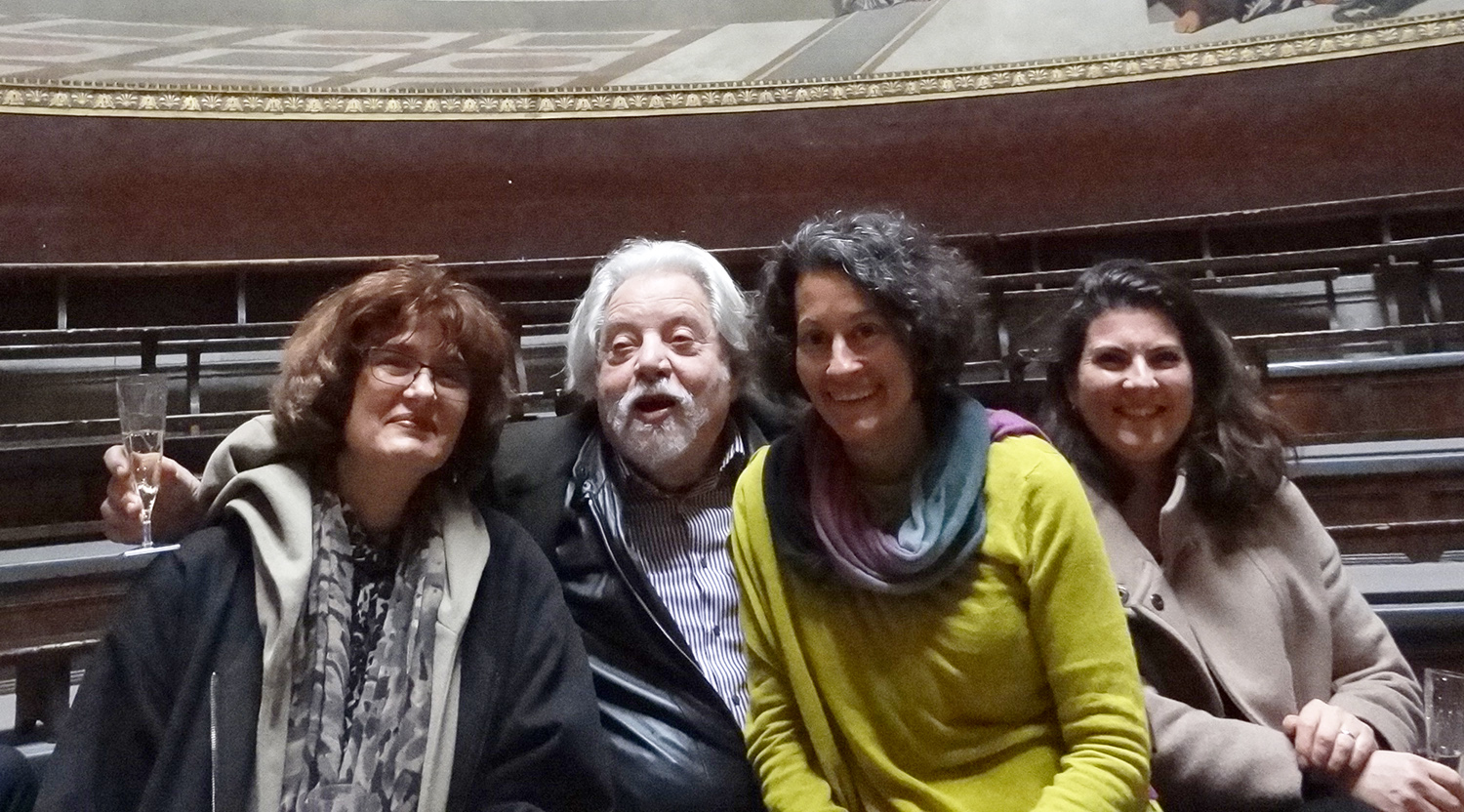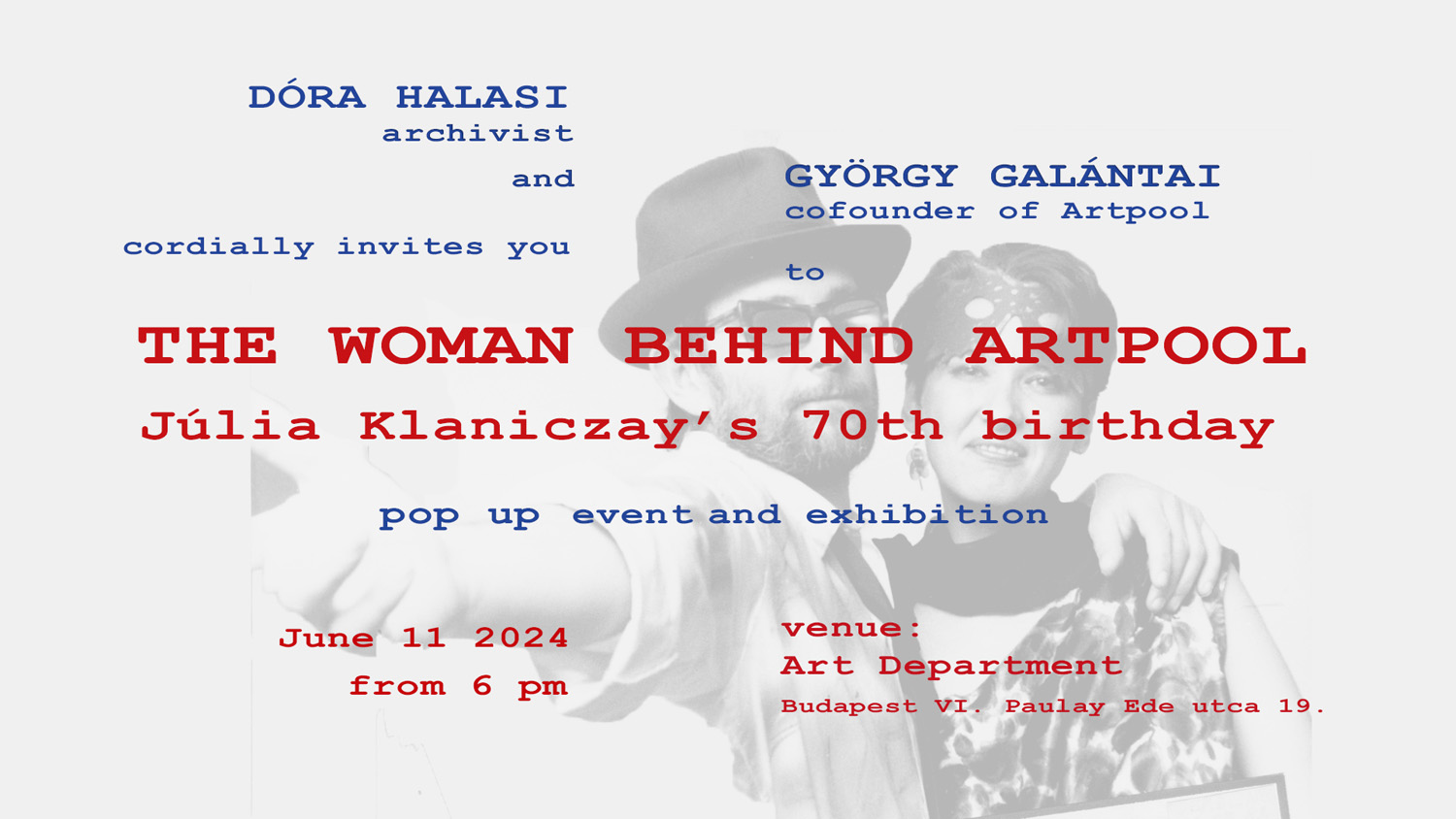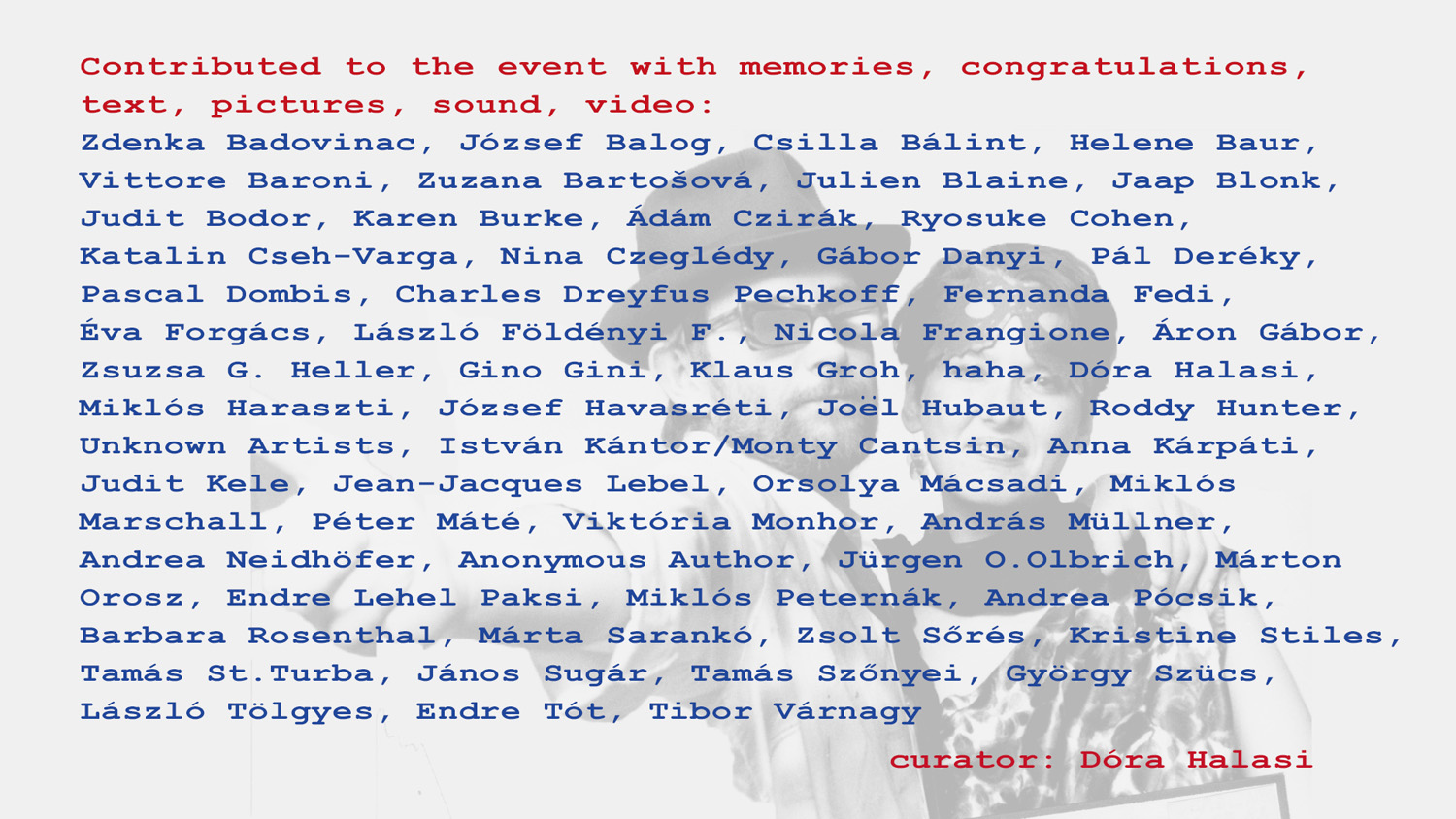Messages d'anniversaire et souvenirs à l'occasion du 70e anniversaire de Júlia Klaniczay, cofondatrice d'Artpool ◼︎ Birthday messages and memories on the occasion of the 70th birthday of Júlia Klaniczay, co-founder of Artpool
Jean-Jacques Lebel

Júlia Klaniczay, Jean-Jacques Lebel, and Rachel Stella at the Beaux-Arts de Paris in 2015
ALLO BUDAPEST ? ICI PARIS…
La figure de JULIA KLANICZAY qui s’est imprimée dans ma mémoire et que je sauvegarde précieusement, est celle d’une présence amicale agissante, éminemment européenne donc polyglotte, en mouvement perpétuel. Elle constitue ce qu’il est convenu d’appeler une « exception » en ceci qu’elle ne s’est jamais resignée au rôle de passive victime des circonstances et qu’elle a réussi à traverser sinon à surmonter les graves crises existentielles dont son pays natal a été le théâtre aux XXème et XXIème siècles.
C’est miracle, qu’elle ait gardé intacte sa dignité d’artiste et d’intellectuelle et c’est en cela, précisément, qu’elle représente à mes yeux l’exemple vivant de ce que Deleuze et Guattari appelaient « un personnage conceptuel », c’est-à-dire quelqu’un qui n’a pas hésité à consacrer son temps et son énergie vitale à intervenir dans le réel de façon à l’infléchir et, en fin de compte, à le modifier un tant soit peu.
Il serait donc insuffisant de définir Julia comme un simple personnage-clé de la contre-culture et de l’art contemporain en Hongrie car, en fondant et en animant Artpool avec son mari György Galántaï – artiste de la galaxie Fluxus – elle a, depuis des décennies, incarné et impulsé cette même contre-culture à la fois locale et internationale.
Grâce à Artpool, il existe en Hongrie une alternative viable à l’art officiel, à la crétinisante économie du marché et à la « servitude volontaire » qui caractérisent l’idéologie dominante. Artpool – centre de documentation, de recherche, d’archivage et de production consacré aux arts expérimentaux du monde entier est la preuve absolue que Rimbaud disait vrai lorsqu’il proclamait « La vraie vie est ailleurs ».
A l’inverse de Polyphonix – autre mouvement transculturel autogéré – qui a pris le parti du nomadisme et de l’errance, Artpool s’est incrusté et installé durablement dans le tissu socio-culturel magyar afin d’y assumer une fonction précise: l’anamnèse.
Comme tant d’autres alliés et amis – européens ou extra-européens – de Artpool, j’en ai fait personnellement l’expérience alors que j’étais de passage à Budapest, en 1998, à l’occasion d’une exposition monographique de mon travail au Musée d’Art Moderne – encore domicilié en ce temps-là dans un vaste et glacial palais de marbre rouge qui, à l’abjecte ère stalinienne, avait hébergé un quelconque ministère – Julia en a profité pour m’inviter à participer à des actions subtilement subversives qui ont fait la réputation de Artpool.
Julia ou quelqu’un proche d’elle, avait découvert enfoui et couvert de poussière dans un meuble de rangement du Musée de Budapest, plié, abandonné et complètement oublié au fond d’un tiroir, un chef d’œuvre du grand Robert Filliou (qui fut dans les années du Festival de la Libre Expression, à Paris, un de mes acolytes les plus joyeux). C’était PoÏ-PoÏ, la célèbre installation spatiale et sculpturale que Filliou, par un acte d’une extraordinaire générosité, avait offert à un fonctionnaire de musée. Ce Poï-Poï est aussitôt tombé dans un trou de mémoire institutionnel, à l’instar de milliers d’autres cadeaux faits par des artistes, ensevelis dans les entrailles de la bureaucratie muséale.
Convenablement dépoussiéré, restauré, déployé dans l’espace et accroché par les soins de l’équipe d’Artpool, le Poï-PoÏ fut donc re-découvert, réanimé et célébré à sa juste valeur. Je fus chargé d’en assumer la partie audible en y improvisant un poème sonore dédié à mon vieux copain Robert, bouddhiste fervent , temporairement réincarné et ressuscité ce jour-là ,à Budapest, par la grâce de Julia et de ses collègues. L’art et la métempsychose ont, surtout pour les bouddhistes partie liée. D’autre part, il se pourrait que cet immémorial processus de recyclage ininterrompu qui a pour nom « mouvement brownien », ait été une des lointaines sources méditatives de ce que Nietzsche a défini comme « l’éternel retour ». Autrement dit ,la répétition du même à l’infini.
Le fameux palindrome attribué à Virgile et repris par Debord, déjà, partageait ce pessimisme radical :
IN GIRUM IMUS NOCTE ET CONSUMIMUR IGNI
(Nous tournoyons dans la nuit et nous voilà consumés par le feu).
Si cette hypothèse s’avère exacte, Artpool (comme nous tous) a du pain sur la planche !
Jean-Jacques Lebel
(février 2024)
HALLO, BUDAPEST? THIS IS PARIS…
The image of JULIA KLANICZAY that has remained etched in my memory and that I treasure so dearly is that of a friendly, active presence, eminently European and therefore multilingual, in perpetual motion. She is what we might call an “exception” in that she never resigned herself to the role of passive victim of circumstances and managed to survive, if not overcome, the serious existential crises that her native country experienced in the 20th and 21st centuries.
It is a miracle that she has kept intact her dignity as an artist and intellectual and it is precisely in this that she represents, in my eyes, a living example of what Deleuze and Guattari called “a conceptual character,” that is, someone who has not hesitated to devote her time and vital energy to intervening in reality in order to influence it and, ultimately, to change it, even if only a little. It would therefore be insufficient to define Julia solely as a key figure in Hungarian counterculture and contemporary art, because by founding and running Artpool with her husband György Galántaï—an artist from the Fluxus galaxy—she has embodied and promoted this same local and international counterculture for decades.
Thanks to Artpool, Hungary has a viable alternative to official art, the mind-numbing market economy, and the “voluntary servitude” that characterize the dominant ideology. Artpool—a documentation, research, archiving, and production center dedicated to experimental arts from around the world—is absolute proof that Rimbaud was right when he proclaimed, “True life is elsewhere.”
Unlike Polyphonix—another self-managed transcultural movement—which embraced nomadism and wandering, Artpool became firmly rooted in the Hungarian socio-cultural scene in order to fulfill a specific function: remembering.
Like so many other allies and friends of Artpool, both European and non-European, I experienced this firsthand when I was visiting Budapest in 1998 for a solo exhibition of my work at the Museum of Modern Art, which at the time was still housed in a vast, cold red marble palace that, during the abject Stalinist era, had housed some ministry or other. Júlia took the opportunity to invite me to join a subtly subversive action, the kind that Artpool is famous for.
Julia, or someone close to her, had discovered, buried and covered in dust in a storage cabinet at the Budapest Museum, folded, abandoned and completely forgotten at the back of a drawer, a masterpiece by the great Robert Filliou (who was one of my most joyful companions during the years of the Festival de la Libre Expression in Paris). It was PoÏ-PoÏ, the famous spatial and sculptural installation that Filliou, in an act of extraordinary generosity, had given to a museum official. This Poï-Poï immediately fell into an institutional memory hole, like thousands of other gifts made by artists, buried in the bowels of museum bureaucracy.
Properly dusted, restored, displayed in the space, and hung by the Artpool team, the Poï-PoÏ was rediscovered, revived, and celebrated for its true value. I was tasked with providing the audio accompaniment, improvising a sound poem dedicated to my old friend Robert, a devout Buddhist who was temporarily reincarnated and resurrected that day in Budapest, thanks to Julia and her colleagues. Art and metempsychosis are closely linked, especially for Buddhists. On the other hand, it could be that this immemorial process of uninterrupted recycling known as “Brownian motion” was one of the distant meditative sources of what Nietzsche defined as “the eternal return.” In other words, the repetition of the same thing ad infinitum.
The famous palindrome attributed to Virgil and repeated by Debord already shared this radical pessimism:
IN GIRUM IMUS NOCTE ET CONSUMIMUR IGNI
(We whirl around in the night and are consumed by fire).
If this hypothesis proves correct, Artpool (like all of us) has a lot on its plate!
Jean-Jacques Lebel
(February 2024)

